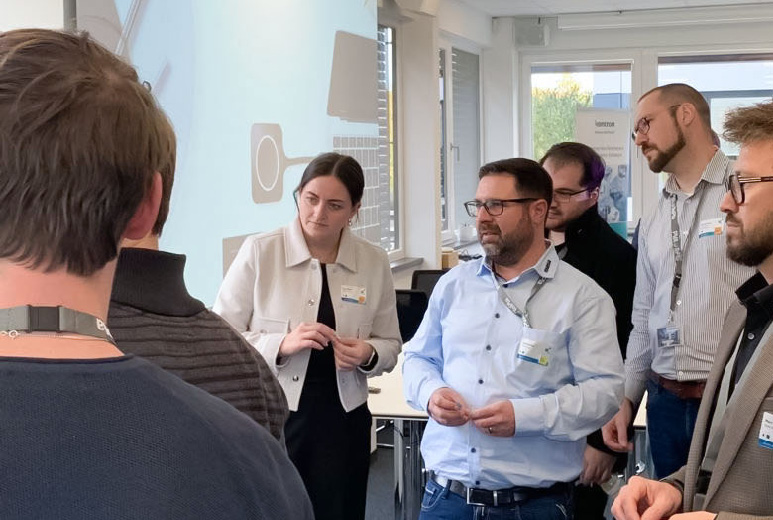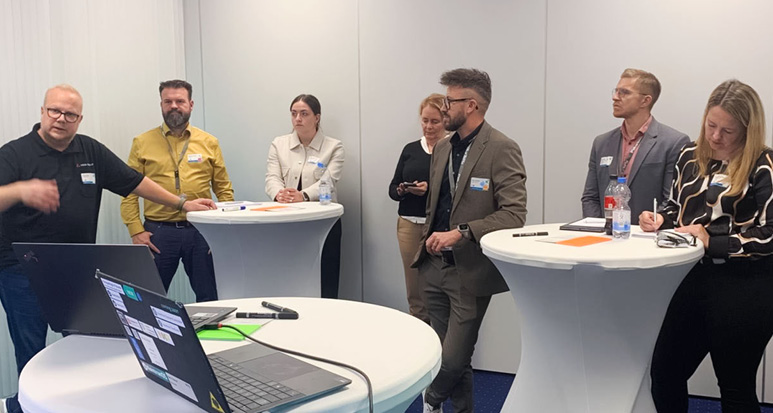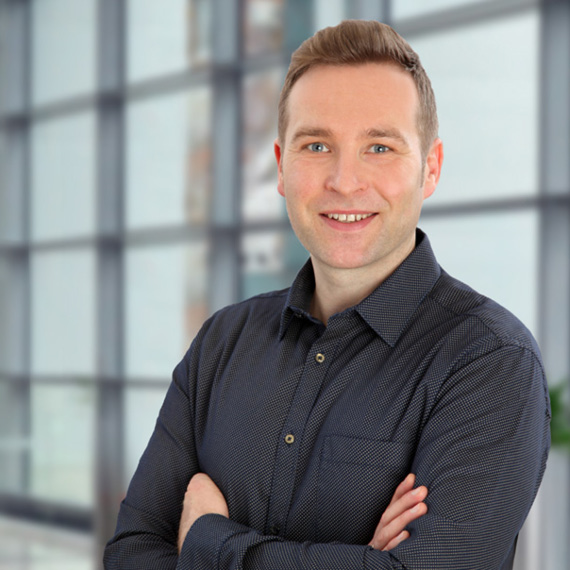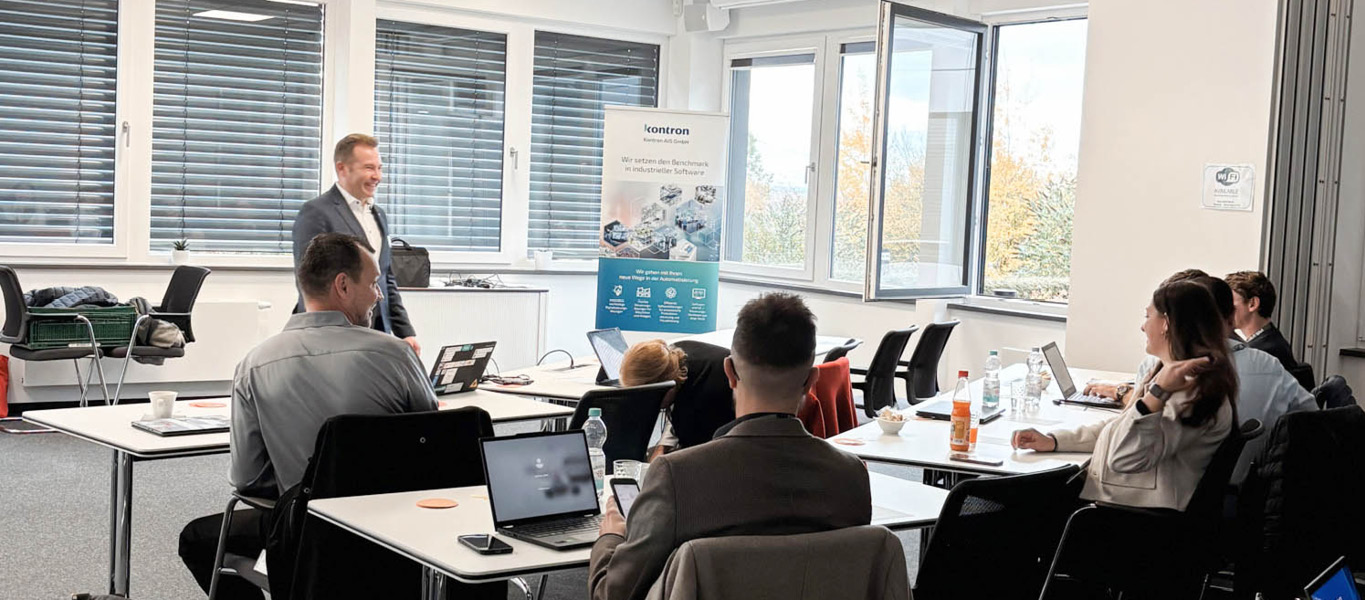In this blog post
Workshop 1: Connecting machines – secure and scalable connectivity
Workshop 2: Transformation that works – how to plan and run projects successfully
Workshop 3: From product to service – how to develop digital business models
The Meet Up “Equipment Manufacturing Goes Digital” Creates Space for Real Exchange

What happens when equipment manufacturers, service teams and digitalization experts come together? They listen to each other. They ask tough questions. And they speak openly about what works and what doesn’t. This year’s meet up “Equipment Manufacturing Goes Digital” at PVA TePla in Wettenberg showed how valuable this kind of honest conversation can be.
In an industry where processes have grown over decades and investments follow long cycles, digitalization is not a simple equation. That makes it even more important to share experiences, learn from each other and gain new perspectives.
The day was built around that goal. Listen, join the discussion, question things. From practical insights to a transparent look at ongoing projects to workshops where real challenges were tackled.
This Is How the Day Started
Kontron AIS Sales Manager Martin Falsner and Till Stoermer from PVA TePla opened the meet up with a look back at five years of digitalization in equipment manufacturing. The focus was not on success stories but on the real challenges teams face every day. How do you create structures that last? What can we learn from past projects? And why is it so important to see digitalization not as a one time task but as an ongoing process? To make transformation work you need different types of people, from pioneers and builders to doers, multipliers and sponsors.


After that, Stefan Köhler and Thorsten Hardt from PVA TePla showed how digital service concepts are being put into practice inside the company. The key question was how digital tools can improve customer satisfaction through faster response times, transparent information and better control of processes. One example is the universal consolidation of data collection across different machine types. It also became clear that digital tools alone are not enough. What matters is that people are able and willing to work with them.
Rafael Seifert from RAMPF picked up on that point and spoke openly about his experience with change management. Many digital projects do not fail because of technology but because of internal resistance or missing communication. His talk showed why it is essential to communicate changes early and clearly, involve teams and set realistic expectations.
After a short break, Kontron AIS presented product highlights. Product Manager Vanessa Kluge and Head of R&D Thomas Dreyer introduced key functions and updates in areas such as monitoring and digital service processes. A major focus was the use of AI in operational service. The goal is to provide information faster, answer follow up questions more efficiently and give teams a clearer view of project and machine states. AI is not meant to replace anyone. It is designed as an assistant to ease the workload in service and support.
The planned roadmap for 2026 followed. The format was intentionally open. Participants could give feedback, share their challenges and add their perspectives. The exchange was practice oriented, centered on real use cases, technical needs and strategic priorities. In after sales in particular it became clear how important it is to check ideas with users early before decisions are locked in.
After that the group toured the production area at PVA TePla. Participants got a close look at the production floor and the TechHub. The tour offered a transparent view of the technological progress PVA TePla achieves in high temperature vacuum systems, plasma technology and crystal growth systems for the semiconductor sector.
In the afternoon three small group workshops tackled three core questions.
Workshop 1: Connecting Machines – Secure and Scalable Connectivity
The first workshop was led by Thomas Dreyer together with Stefan Köhler from PVA TePla. The group focused on how to connect machines to modern IT environments in a clean and cost effective way.
Participants started by gathering the issues they deal with every day. The list was long: data protection, cybersecurity, countless interfaces, limited IT resources, rising cloud costs. The variety of technical connections from OPC DA and UA to S7 and MES systems showed how complex and individual many setups are.
From that discussion came the idea of a standardized switchboard. Instead of building separate point to point connections, the group considered using an intermediate layer. Machines and the factory would communicate through a shared standard layer. That reduces complexity and creates more transparency for customers because they can see which data is used and how.
Possible solutions discussed included FabEagle Connect and Node RED. On the technical side KontronOS and KontronGrid moved into focus as ways to run devices securely, update them and manage them centrally.
In the end the group summarized the core requirements for a scalable solution:
- a secure and easy to maintain hardware platform
- a robust operating system with a clear update strategy
- flexible standardized data connectivity for example with FabEagle Connect
- central management of all IoT components with KontronGrid
- transparent communication about which data is collected and used
In a short practical example, Stefan Köhler showed how PVA TePla already applies these ideas with a clear intermediate layer, integrated monitoring tools and a standardized setup for device management.

Workshop 2: Transformation That Works – How to Plan and Deliver Projects Successfully
This workshop focused on a question many teams struggle with. Why do digital projects often fall short of what people expect? Vanessa Kluge led the session together with Richard Stegmann from MackSmaTec who shared their ongoing projects and experiences openly. The goal was to work with the group to understand what makes transformation succeed in practice and what slows it down.
Right from the start one thing was clear. Most projects do not fail because of missing technology but because of missing clarity. Unclear responsibilities, vague goals and scattered initiatives slow progress more than any system limit.
The group worked out which conditions need to be in place for digital projects to have an impact. This was not about technical details but about structural basics. Clear roles, internal resources, leadership, direction and communication. If digitalization is seen only as an IT task it will hit limits sooner or later.
To get a common picture the group used a maturity timeline to place themselves. Most companies are somewhere between Connected Products and Data Driven Business. Digital applications exist in parts but are not yet consistent or strategically developed. This view helped set the right priorities for next steps and discuss them together.
A valuable part of the workshop was the insight into how MackSmaTec approaches projects. Their openness about setbacks, detours and resource gaps helped many participants. At the same time it became clear that change is possible with small steady steps. Through targeted training, building key users, a roadmap that is actually used or internal actions that make progress visible.
Key takeaways from the workshop
- Transformation needs structure. Roles, goals and clear responsibility
- Without internal commitment and enough resources no project reaches the finish line
- Early involvement of departments ensures relevance and acceptance
- A central roadmap helps keep an overview. It should be reviewed, adjusted and actually used
- Small visible wins build trust in the process
- Digitalization is not a side topic. It belongs in the company strategy
At the end the group collected common mistakes and open questions. Many said they would communicate earlier internally or rely more on user feedback if they could start again. Others stressed how important it is to promote digital projects inside the company with strategy days, cross team alignment or internal launch events that make new topics visible.

Workshop 3: From Product to Service – Developing Digital Business Models
The third workshop tackled a key question. How do you move from being a classic product supplier to becoming a real service provider? Martin Falsner led the session together with Tobias Pistor from the HESS Group. Their goal was to make the opportunities, hurdles and requirements for new digital service offerings tangible based on real product lines.
Participants were split into three groups. Each group worked with an example from their own business context: laser systems, crystal growth machines and a concrete block production line. The first step was to describe the current customer experience. In many cases the result was sobering. No one reachable. Help. Wrong spare parts. No one feels responsible.
With a shift in perspective inspired by a quote from Steve Jobs, begin with the customer experience and work back to the technology, the groups focused on the customer’s view. The idea was to move away from product thinking and start with the real usage experience. New service ideas should grow from there.
That was not easy. The reflex to think in product logic came back quickly. But with some guidance the groups managed to stay with the customer experience and surface new or already existing service ideas. These included digital assistance systems, targeted guides for common issues or more structured feedback loops in after sales.
The point became clear. The shift toward being a service provider starts in the mind. It takes the willingness to look honestly at the customer experience and use it to shape concrete digital offerings.

Digitalization Thrives on Exchange
The meet up showed how important it is to talk about plans early, share experiences and work on solutions together. The open feedback on the 2026 roadmap was just as valuable as the discussions about using AI in service as real day to day support.
The workshops made one thing clear. Digital transformation needs more than tools. It needs clear goals, solid structures and people who support change inside the company. The small group discussions showed how much knowledge sits inside this community.
After a full day of content the group walked together to Gleiberg Castle. At the top they got a tour with a view over Wettenberg and the surrounding area before ending the evening with good food and personal conversations. The relaxed atmosphere helped deepen connections, spark new ideas and develop thoughts that came up during the day.
The response was strong. So it is clear that Equipment Manufacturing Goes Digital will return next year. The day proved that equipment manufacturing can go digital and that we are right in the middle of it.


